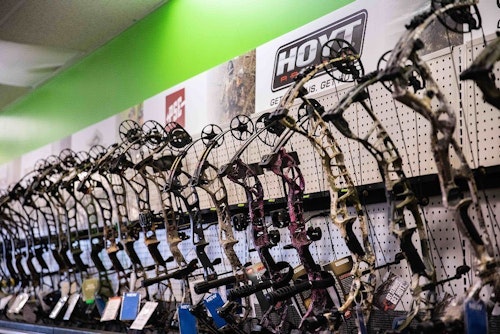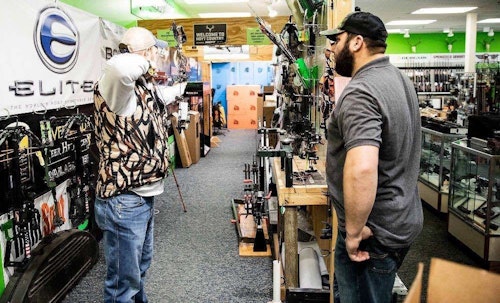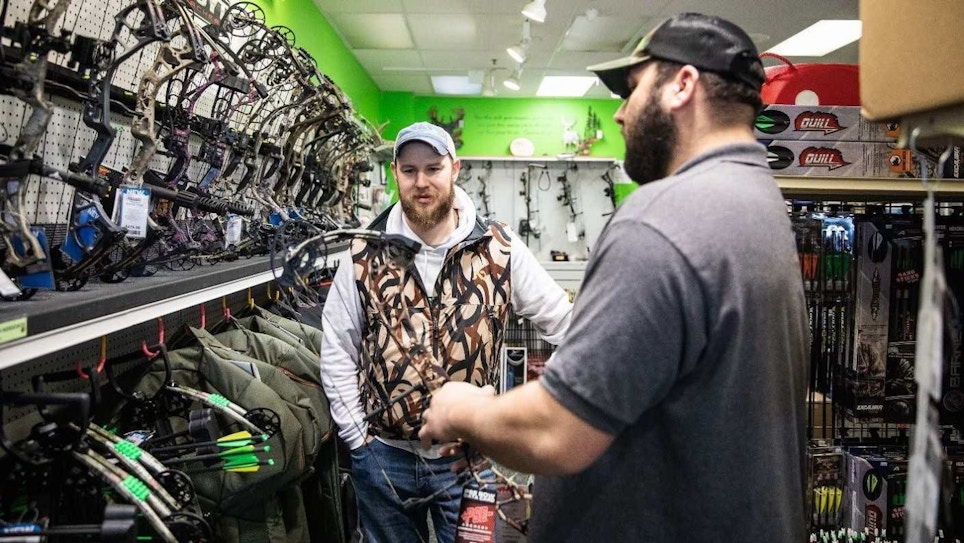All archery dealers face a common challenge: deciding how many bow lines to carry, and then which models, specs and finishes to have in stock. The ultimate goal is to not under-order and lose sales, but also not to over-order and be left with multiple year-old bows when new ones are launched. In a perfect world, you’ll order just right and sell through everything just in time to make room for new models. It’s easier said than done, especially when you consider the numerous brands, models, specs and finishes that exist.
Bow-purchasing decisions can be complex, particularly if you’re a new dealer just starting out. For the first couple of years, you won’t know exactly what to expect, and there will be some guesswork. Even longtime dealers must juggle some metrics to ensure that they purchase wisely. And for that reason, we’ll cover several valuable points in the following paragraphs that will be especially beneficial to newer dealers, but also helpful to virtually all dealers.
Some of the content we’ll address comes from my retail experience, but for additional insights, I sat down with Gary Hintz, owner of Bucks & Bulls Archery in Stevens Point, Wisconsin. Hintz has been at it a long time, and he not only sells bowhunting bows, but also piles of youth and tournament bows. Thus, I consider his input well worth heeding.
Without further ado, consider these points as you navigate your store’s annual bow-purchasing duties.
How Many Brands
Through the years, some brands have emerged and then died, but today, more than 12 very recognizable bow manufacturers are still standing and pumping out new models annually. With all of the cool technologies and also the buzz that looms following each bow launch, it’s easy to be swept into the excitement and bring on a new brand — or three — hoping the leap will yield additional sales.
Be careful! While carrying multiple brands has benefits, there’s a sweet spot. Carry too many, and you’ll confuse your customers, plus it’ll be virtually impossible to sell through everything. Carry too few, and you could lose numerous sales to another dealer or even a box store.
Hintz said, “It takes time to learn which brands have the greatest following in your area. Mathews is my top seller because I’m in Wisconsin where Mathews is based. In another geographic location, it could easily be another compound brand. Once you identify a top-selling brand or two, then add a few other lines so that you have something for most customers.
“I suggest carrying four bow brands. I think it’s overkill to offer six or seven. Plus, it all depends on what you can afford. You can’t afford to stock everything. Earlier in my career, I stocked a few brands that I no longer do. And when I dropped them, I boosted my stock of the brands that sell best. There was some trial and error involved, and I lost some dollars figuring it all out. But, I’ve learned how to buy right, and I gained some lost dollars back.”
High-End, Middle-of-the-Road and Low-End Bows
Once you settle on a handful of bow lines, you must decide how many models in each price category to bring in. Demographics are certainly worth considering, median income being an important factor. That’ll help you peg which price category will be best received. Still, I learned during my retail career that there’s always a market for high-priced flagship bows, even in a small town like the one my family’s store was in. Some customers flat out won’t settle for anything less than the best, even if it means going over budget.
But, with that being said, another bunch of folks realize that a $500-$600 bow can kill a deer just like a $1,500 bow can. Thus, they’re going all in on new bows with accessories for $750-$1,000. Given bow technology advancements, it’s no surprise that many shops are reporting that mid-priced bows are the hottest sellers. I mean, most current mid-priced bows flaunt the same technologies as high-end bows from 3-5 years ago. Thus, they could be considered, in a sense, high-end bows without the high-end price.
Hintz echoed what many dealers have reported over the last several years.
“Mid-priced bows account for about 50 percent of my bow sales,” he said. “About 25 percent are high-end bows, and the remaining 25 percent are low-end bows. Those numbers vary slightly every year, but remain fairly consistent. We sell tons of those mid-priced bows because they’re affordable and have most of the same features as high-end bows. Still, high-end bows sell really strong, too.
“With mid-priced bows, I don’t get too carried away with stocking a bunch of them from different brands. In other words, I buy narrow and deep. Mid-priced-bow buyers are typically less brand-loyal than high-end shoppers, so they’ll usually buy what I have on the rack, especially because I sell only bows I recommend.”
I believe Hintz’s percentages of high-, middle- and low-priced bow sales reciprocate pretty accurately across the map with many dealers, but there are certain dealers I’ve spoken with for my “Behind the Counter” column who sell high-end bows almost exclusively. In order to do that, location is important, but also, you must position your store and its branding as an ultra-premium high-end store. And, you’ll certainly lose customers if you sell high-end bows exclusively, because, let’s face it, not all archers can fork out $1,000-1,500 on a bare bow. But I’m not telling you how to run your shop; I’m only providing tips that you can take or leave at your discretion.
Of course, there’s room in every market for entry-level compound bows. Folks who hunt sparingly can buy an entire bow package for $400-$500. Most of these customers aren’t shooting 40 yards. They’re hunting from stands where shots are 25 yards and in, and a low-end bow does everything they need it to at that distance.
Further, new folks are getting into archery and bowhunting constantly. If you keep several highly adjustable bows such as Mission’s $299 HAMMR in stock — it fits most archers (draw length adjusts from 17-29 inches and draw weight from 16-70 pounds) — you’ll easily cover a broad spectrum of low-end customers from youths to adults in a single bow model that’s easy to sell and incredibly affordable.

Draw Lengths and Weights to Have On Hand
When I was a dealer, draw weights and draw lengths were a major contributor to carrying bows over from one year to another. Bows during my tenure had little adjustability because it came at the expenses of efficiency and performance. Today, bow manufacturers have it all fig-ured out, and most bows — even high-end models — offer vast adjustability, which is a big benefit to the dealer.
“I order in just about everything I think I’ll sell,” Hintz said. “Most bows are adjustable enough that I’m not concerned about getting stuck with an odd draw length. It also simplifies ordering bows of different draw weights. I don’t have to decide if I should order a 27.5-inch draw length in a 60- or 70-pound peak weight. I can bring in whatever peak weight I want and know that I can adjust the draw length for multiple archers.
“Mathews, in particular, has simplified bow ordering for dealers. SwitchWeight modules allow me to have 20 bows on the shelf that can be 50 pounds up to 75 pounds, and draw lengths are easily adjusted by swapping the modules, too. One bow can fit various archers by changing modules.”
Dexterity
Another challenge is deciding how many left-handed bows to stock. You might recall that I addressed this topic with a few dealers in Archery Business’ July 2020 issue in my “Behind the Counter” column. Some dealers reportedly keep only one or two left-handed compounds on the shelf and then special-order when those don’t work for a given customer. Other dealers keep at least several on hand. Here again, there’s some trial and error involved.
Hintz shared what works for him: “I’m fairly conservative with left-handed bows. I don’t necessarily do this with each brand, but I usually bring in two each of my best-selling high-end, mid-priced and low-end bows. My sales ratio is about 15 right-handed bows for every five left-handed bows. I also keep a good selection of left-handed accessories on hand. I have more left-handed customers than most would assume.”

Package Bows vs. Bare Bows
Should you offer bare bows that customers can accessorize, package bows that are ready to adjust to customer specs and send out the door, or some of each? There’s merit to both. Some customers love the simplicity of packages. They want to walk in, grab a package bow from the rack, have it set to their specs and buy it. There are more meticulous customers, though, who prefer very specific accessories, and for that reason, having both bare bows and package bows is wise.
“It’s a tossup,” Hintz said. “Half of the bows on my shelf are bare bows, and the other half are packages. If it slants one way more than the other, I’d say the packages are a bit more popular.”
How to Move Unsold Bows
In the event that you end the year with a few of last year’s bows — you will from time to time — you can either knock a percentage off your list price, or you can sell them online, so long as it doesn’t infringe on the bow manufacturer’s dealership policies. The benefit to selling online is that you aren’t selling discounted bows to your regular in-person customers.
Credit Roll
Obviously, what works for Hintz isn’t a cookie-cutter strategy that’ll work for every dealer in every location. However, if you consider the points we’ve address here as guidelines, you’ll make wiser purchasing decisions and sell more bows without the headache of a couple dozen leftovers when the new bows launch. To that end, study your customers’ bow-buying tendencies over a couple of years. Learn what works and doesn’t works, tweaking your ordering strategy until it’s on point.
Even then, expect sales fluctuations from year to year. Some years, bow manufacturers make only subtle improvements, and that can incite fewer sales. Other years, economic shifts could influence sales positively or negatively.
Bow purchasing is certainly a balancing act, but by heeding the advice presented here, you can create a killer plan for stocking and moving compound bows in your store.
Sidebar: Compound Bow Finishes
Flashy finishes are the thing for some folks, and there’s certainly merit to bow customization. The problem is that knowing what customers want is tough when bows are offered in as many as 15 finishes. I suggest stocking extremely shallow in terms of colored finishes and less-popular camo finishes. Offer a good selection of popular camo and neutral finishes, saving anything unordinary for special orders. Often, customers interested in customization are willing to wait, so why bog down your shelf with risky colors that may or may not sell?
Justin Gaiche of Chase Outdoors in Rothschild, Wisconsin, has another school of thought. “I don’t have an indoor range or archery leagues,” he said. “And because of that, I look for ways to differentiate my business. One way I do that is to stock a good selection of different finishes. Obviously, the staple camps like Realtree and Mossy Oak are safe bets, but since I’m a Sitka Gear dealer, I keep plenty of bows on hand in Subalpine and Elevated II. I have a lot of customers who hunt the West, so the western-flavored camos are sought after here.
“Further, I handle numerous finishes on accessories, too. Some folks want their rig to match from top to bottom, and while it can be difficult to offer, say, 10 different quivers, my customers appreciate all of the options.”
Sidebar: How to Set Up Bows for Customers to Test
Most customers, even if they’ve already decided which bow to buy, want to test-fire a bow be-fore buying it. How you set up a bow to be test-fired can positively or negatively influence the customer’s impression of both the bow and you. When you make sure it’s adjusted to their specs, they’ll have the confidence that you’ll do a high-quality job with the set up when they buy the bow. Plus, the bow will feel far better as they test it, increasing the opportunity to sell it.

You don’t necessarily have to set it up with all of the trimmings, but always make sure to adjust the draw length and weight to your prospective customer’s specs. Also, install a full-containment rest and a D-loop. If the customer didn’t bring in his/her own release, make sure to fit them with one that’s the same style as they’re currently using. Or, if they’re entirely new to archery, let them test-fire the bow with a safe release that’s easy to use, such as an index-finger release with a wrist strap.






